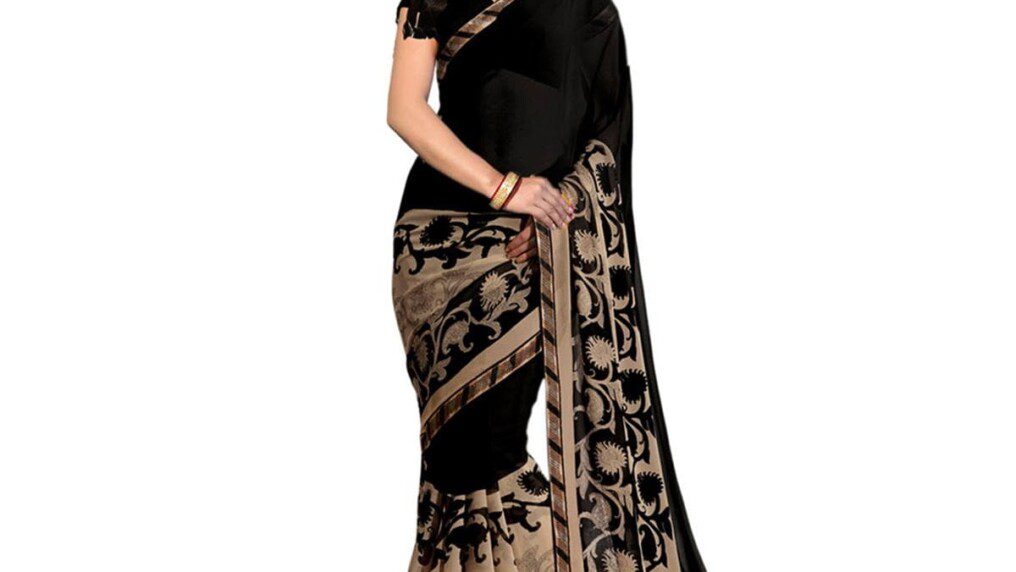
A garment typically worn by women, which has a drape of the length of approximately 4.5 -8 meters and breadth 0.6 -1.2 meters, which adorns the waist and one end falls over the shoulder where the midriff is exposed. This garment has originated from the Indian subcontinent. It is paired with a fitted blouse or bodice known as choli and petticoat. It is considered to be the cultural identity of Indian women.
What are the different ways of draping a sari?
There are a number of ways to drape a sari which varies with regions, states and cultures. Some most common ways are listed below:
- Himalayan: It is worn in the regions of Himachal and Uttrakhand. It is a woolen sari known as Kulluvi Pattu.
- Nivi: It is worn in the Deccan regions and the pleats of the sari passed between the legs and tucked at the waist allowing free movement.
- Bengali/Odia: This sari is draped in an anti-clockwise manner and does not have pleats and then from the opposite direction, the other end falls over the left shoulder.
- Rajasthani/Gujarati/Pakistani: it is pleated like in Nivi style but later the other end falls over right shoulder and is secured around the back.
- Maharashtrian: Placing the center of sari at the back, the two ends are tied at the front and wrapped securely around the legs.
- Tribal style: it is often worn in a way just to cover the breasts by tying across chest firmly.
Types of sari from across India:
India is known for its diverse culture and traditions and in different states, women adorn different styles and types of the sari. Here is a list of the must-haves for every woman:-
- TAANT: is the famous sari from West Bengal and is worn in everyday wear in Bengal as it is made from cotton. The beautiful prints and thick borders make them look elegant and pretty.
- KANJEEVARAM: is the famous sari of Tamil Nadu and is traditionally made of silk. It is known as the sari queen. They are graceful and vibrant.
- KONRAD: is another specialty of Tamil Nadu and were traditionally made for temple deities. It has patterns like checks or stripes and a thick border, which makes it so special because of the motifs of natural elements and animals.
- CHANDERI: is the special sari of Madhya Pradesh woven using silk, cotton, and zari. It gives that royal gorgeous look and is light in weight.
- BANARASI: sari is Varanasi special and has beautiful silver and gold designs of Zari. Originally these were made of real silver and golden threads.
- MUGA: sari from the state of Assam made of muga silk is very durable and glossy.
- BANDHANI: is the famous sari from Gujarat made by the procedure of dye and tie.
- PAITHANI: is a specialty of Maharashtra basically Aurangabad. It is an elegant sari handwoven from silk. Peacock designs, motifs, and zari border are what make it special.
- KASAVU: is also known as settu sari and is traditionally only a dhoti worn with a blouse and stole is the specialty of Kerala and the main feature is the white golden border.
- SAMBALPURI: is from Odisha woven delicately by using different techniques with dyed threads
- BOMKAI: which is also referred to as Sonepuri silk is famous from the state of Odisha. It is a beautiful work that consists of intricate designs made using threads and fabulous embroidery. It is usually worn at the festival.
- POCHAMPALLY: is the specialty of the boodhan town of Telangana in Andhra Pradesh. It is the perfect blend of cotton and silk and has beautiful geometrical ikat patterns.
- LEHERIYA: which is an alternative Bandhani and is a specialty of Rajasthan. It follows an immensely beautiful technique of dye and tie. It is different from Bandhani in the way tying of the cloth is done while it is being dyed.
- CHIKANKARI: is the famous exclusive saree of Lucknow was traditionally made from a cloth material called muslin, however, now it is made of various other fabrics.
- PHULKARI: which literally means floral work is famous from the state of Punjab. The flowers are made in vibrant shades of thread. The phulkari embroidery is popularly seen in dupattas with a khadi or cotton base.
- BHAGALPURI SAREES: which are also called Tasar silk sarees is traditionally made in the state of Bihar.
- BALUCHARI: saris originated from West Bengal and showcase borders which narrate epic stories like Mahabharata and Ramayana.
Sari neck designs:
- Round neck: it is ready to go option which keeps you on the safe side without any hassle.
2. Square neck: you can look absolutely stunning with this neck design if you have lean shoulders.
3. Chinese collar neck: this gives a classy look and has a very simple tailoring.
4. Halter neck: if you want to give a fashion statement and look glamorous, this design is your best choice.
5. Cape style neck: though comparatively new, this design is pretty simple yet classic and makes you look graceful.
6. Jewelled neck: if you are looking forward to a blouse that can make a simple sari work, you are at the right stop.Where to look for these?
Saris have been a part of our tradition for a long period of time and that is why you will find it everywhere in all colors, designs, styles, lengths, patterns, prints and fabrics. Stylecaret is a one stop destination if you want to go through a collection of all these amazing saris of different states and styles and make your own collection. Online shopping makes it so much easier to access a larger variety without much time and travel and sites like Stylecaret do this job the best.
Sari is our Indian culture and has been part of us for decades. Saris make a woman look elegant and beautiful. They are an adornment for women of India.
Read Also:
































